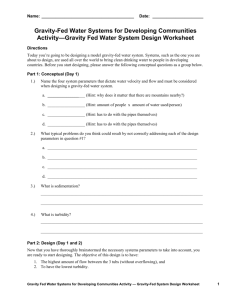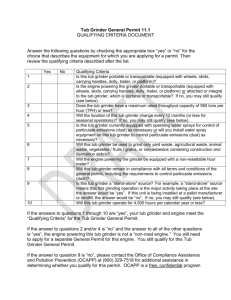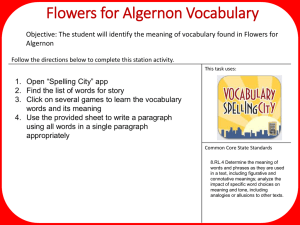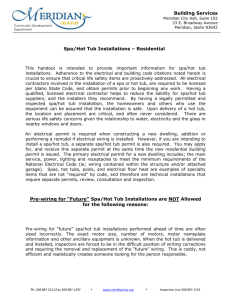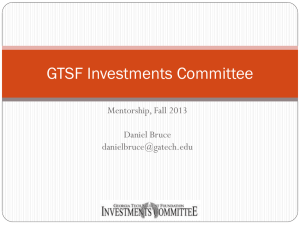Systems Theory
advertisement
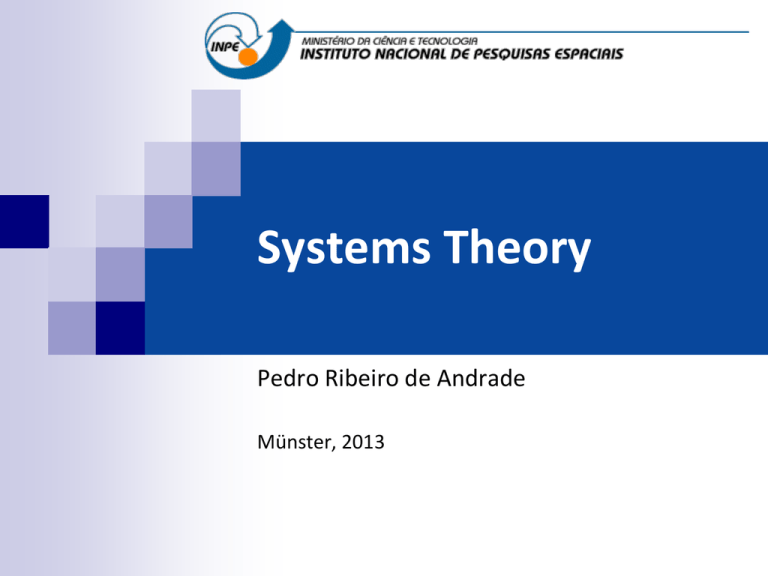
Systems Theory Pedro Ribeiro de Andrade Münster, 2013 Geoinformatics enables crucial links between nature and society Nature: Physical equations Describe processes Society: Decisions on how to Use Earth´s resources How to model Natural-Society systems? Connect expertise from different fields Make the different conceptions explicit If (... ? ) then ... Desforestation? “A hypothesis or theory [model] is clear, decisive, and positive, but it is believed by no one but the man who created it. Experimental findings [observations], on the other hand, are messy, inexact things, which are believed by everyone except the man who did that work” Harlow Shapley (1885-1972), American astronomer Models “[The] advantage of a mathematical statement is that it is so definite that it might be definitely wrong…..Some verbal statements have not this merit; they are so vague that they could hardly be wrong, and are correspondingly useless.” Lewis Fry Richardson (1881-1953) – first to apply mathematical methods to numerical weather prediction What is a System? Definition: A system is a group of different components that interact with each other Example: The climate system includes the atmosphere, oceans, polar caps, clouds, vegetation…and lots of other things How do we study systems? • Identify the components • Determine the nature of the interactions between components Earth as a system P h y s ic a l C lim a te S y s te m C lim a te Change A tm ospheric P hysics/D ynam ics O cean D yn am ics T errestrial E n erg y/M o istu re H u m an A ctivities G lo b al M o istu re M arin e B io g eo ch em istry T errestrial E co system s T ro p o s p h e ric C h e m is try B io g e o c h e m ic a l C y c le s (fro m E art h Syst em S cie nce : A n O ve rvie w , N A S A , 1 98 8 ) S o il C O2 La nd Use C O2 P olluta nts Systems Theory Provides a unified classification for scientific knowledge. Enunciated by biologist Ludwig Von Bertalanffy: 1920s: earliest developments 1937: Charles Morris Philosophy Seminar, University of Chicago 1950: “An Outline of General Systems Theory”, Journal for the Philosophy of Science Scientists that introduced Systems Theory in their fields: Parsons, sociologist (1951) J.G Miller, psychiatrist & psychologist (1955) Boulding, economist (1956) Rapoport, mathematician (1956) Ashby, bacteriologist (1958) Short History of System Dynamics The System Dynamics approach was developed in the 1960s at M.I.T. by Jay Forrester. A system in Modelica Conception of Reality Any measurable part of reality can be modeled Systems are represented as stocks and flows Stocks represent energy, matter, or information Flows connect and transport stocks Systems are opened or closed A system Can you identify parts? and Do the parts affect each other? and Do the parts together produce an effect that is different from the effect of each part on its own? and perhaps Does the effect, the behavior over time, persist in a variety of circumstances? Source: (Meadows, 2008) Systems Building Blocks Stocks Flows Information Links Decision Points Converters Auxiliary Variables slide 15 Stocks “Things” that accumulate in a system Physical or non-physical things Value is a quantity or level Persistent (remain even if all flows stop) Conservation (stock units enter from environment and return to environment) slide 16 Flows Movement of “things” in and out of stocks Not persistent (can be stopped and started) Value is a rate of change (will always have a time dimension) Flow unit = stock unit / time The unit of measurement for a flow will always be the unit of measurement of a stock divided by an element of time slide 17 Stock and Flow Diagram Stocks in boxes Flows as straight double arrows Information Links as thin curved arrows Decision Points as closed in X slide 18 System Dynamics Modelling Control Material Flaw to Stock Control Material Flaw from Stock Stock Send information from the Stock Add New information Shrimp farming Simple model for shrimp farm Results? Figure 7 Positive Coupling Atmospheric CO2 Greenhouse effect • An increase in atmospheric CO2 causes a corresponding increase in the greenhouse effect, and thus in Earth’s surface temperature • Conversely, a decrease in atmospheric CO2 causes a decrease in the greenhouse effect Negative Coupling Earth’s albedo (reflectivity) Earth’s surface temperature • An increase in Earth’s albedo causes a corresponding decrease in the Earth’s surface temperature by reflecting more sunlight back to space • Or, a decrease in albedo causes an increase in surface temperature The interesting thing to do is to put couplings together in feedback loops… Negative Feedback Loops: Electric Blankets person A’s body temperature person A’s blanket temperature person B’s blanket temperature person B’s body temperature A Positive Feedback Loop: Mixed-up Electric Blankets person A’s body temperature person A’s blanket temperature person B’s blanket temperature person B’s body temperature A Positive Feedback Loop: Mixed-up Electric Blankets Any perturbation will cause both people to adjust their blanket controls, but with undesired consequences. Ultimately, one person will freeze (become infinitely cold) and the other person to swelter (become infinitely hot). Equilibrium State: Conditions under which the system will remain indefinitely --If left unperturbed An Unstable Equilibrium State An Unstable Equilibrium State Perturbation When pushed by a perturbation, an unstable equilibrium state shifts to a new, stable state. A Stable Equilibrium State A Stable Equilibrium State Perturbation When pushed by a perturbation, a stable equilibrium state, returns to (or near) the original state. Tools for system dynamics Dinamo Vensim Simile STELLA Water in the tub Initial stock: water in tub = 40 gallons water in tub(t) = water in tub(t – dt) – outflow x dt t = minutes dt = 1 minute Runtime = 8 minutes Outflow = 5 gal/min Cell (description extracted from “TerraME types and functions”) Event Temporal model (1) Get first EVENT 1:32:00 cs:load( ) 1:32:10 ag1:execute( ) 1:38:07 ag2:execute( ) 1:42:00 cs:save() (2) Update current time (3) Execute the ACTION ... (4) ACTION return value true false (5) Schedule EVENT again Source: (Carneiro et al., 2013) Observer Water in the tub Initial stock: water in tub = 40 gallons water in tub(t) = water in tub(t – dt) – outflow x dt t = minutes dt = 1 minute Runtime = 8 minutes Outflow = 5 gal/min Water in the tub 2 Initial stock: water in tub = 40 gallons water in tub(t) = water in tub(t – dt) – outflow x dt t = minutes dt = 1 minute Runtime = 8 minutes Outflow = 5 gal/min Inflow = 40 gal every 10 min Conclusions Two ways to increase stocks Stocks act as delays or buffers Stocks allow inflows and outflows to be decoupled

